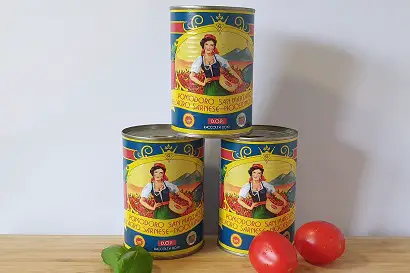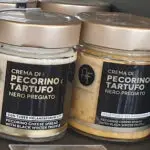If there are two words that come to mind when you think about Italian cooking, they are “fresh” and “authentic”. Although we tend to imagine every ingredient in every recipe will be direct from the garden, that’s not always going to be practical. With that in mind, do Italians use canned tomatoes?

You might be surprised to hear that canned tomatoes, and other preserved tomato options like passata, are a universal staple in Italian home cooking.
Read on to find out how and why canned tomatoes can be found in so many Italian recipes.
Are Canned Tomatoes Part of Authentic Italian Cooking?
You’ve heard it a hundred times: the freshness of your ingredients is one of the most important ways to get good flavor and quality, but that’s not necessarily always true. Though you might imagine hand-picking your own tomatoes for an Italian recipe is going to be the best way to go, most nonnas would actually disagree.
Italians use canned tomatoes, passata, and tomatoes and sauces in glass jars on an almost daily basis – for many traditional home-cooked recipes.
You might not get quite as much freshness and flavor as you do with raw tomatoes off the vine, but they are infinitely more practical and much easier to get your hands on.
Don’t forget that tomatoes actually have a limited picking season (from June to September in Italy), so there are large parts of the year when local farms are not able to offer healthy produce that has not been preserved or grown in expensive greenhouses.
Are Canned Tomatoes Different In Italy?
Of course, one of the important things to keep in mind when we say that Italians use canned tomatoes often in their cooking is that their canned tomatoes are a little different.
In Italy, preserved tomatoes and tomato sauces tend to be more simplistic and intense in terms of their flavor. They do not include sugars and other additives, and they avoid refrigerating their tomatoes as this waters down the taste.
Using an air-tight container to preserve tomatoes is actually an Italian invention, first produced by a man named Francesco Cirio in 1856 as a way to sell his goods in the UK market. This innovation is arguably one of the main reasons why Italian cuisine makes so much use of tomatoes today.
The tomatoes themselves are typically Roma tomatoes, which are the most iconic for use in sauces and pastes.
Do Italians Prefer Fresh Tomatoes For Cooking?
At the end of the day, many Italians do like to use fresh tomatoes when they can, but it is much more of a hassle and just isn’t a reasonable option for a lot of the year.
When fresh tomatoes aren’t available, it’s preferable to use high-quality and inexpensive preserved options rather than those that have been chilled and shipped over large distances.
You might notice that storing your tomatoes in the fridge means that they will start to become watery and very mild in terms of their flavor. This happens whenever they are kept at cold temperatures, which is why many Italians would opt for an intensely flavored tin instead when there aren’t many fresh tomatoes around.
Equally, a lot of the work has already been done for you when you reach for a can of tomatoes. You don’t need to peel, simmer, reduce, or blend them – and they are already in the perfect form for many of the most important Italian recipes.
Authentic Italian Recipes With Canned Tomatoes
So, if Italians do use canned tomatoes in their cooking, what kind of recipes revolve around this particular ingredient? Let’s take a look at some authentic Italian classics that make excellent use of the humble canned tomato.
Pizza
Perhaps the most iconic and world-renowned use of tomato sauce is on pizza. The base of almost every traditional Italian pizza is a rich tomato sauce, often a passata or made using tomatoes from a tin or a glass jar.
Pizza Margherita is the king of them all, and it only has three simple toppings: tomato sauce, mozzarella, and fresh basil.
Pasta al Pomodoro
There are hundreds of different pasta dishes made using tomato sauce, and every one of them is a delicious and humble meal. Pasta al Pomodoro simply means “pasta with tomato”, and any kind of noodles can be combined with canned tomatoes for a simple, inexpensive daily treat.
Whether you’re using spaghetti, fusilli, penne, or any other shape – tomato sauce is always a delicious accompaniment to one of Italy’s most popular exports.
Parmigiana
There are two very popular kinds of parmigiana: one made using zucchini and the other with eggplant. Both of them, however, incorporate layers of rich tomato sauce and layers of delicious cheese to make a heart-warming and rustic traditional dish that is a real crowd-pleaser.
Polpette al Sugo
Although we might associate meatballs with spaghetti, Italians don’t traditionally eat these two foods together. Instead, they are much more likely to make Polpette al Sugo: juicy meatballs in a delicious tomato sauce.
This dish is a staple in Italian homes and canned tomatoes are the quickest and easiest way to get produce a rich and hearty sauce.
How Long Have Italians Cooked With Tomatoes?
One interesting thing to consider about the use of tomatoes in Italian cooking is that they have not been central to the cuisine for as long as you might think. Although they are now one of the core staples of a wide variety of traditional Italian dishes, tomatoes were actually a relatively recent introduction to the country’s palate.
In fact, tomatoes were first brought to Italy from the Americas, as they did not natively grow in Europe before they were discovered and transported. It is believed that it wasn’t until the 1500s that Italians began to use tomatoes in their cooking when the Spanish rulers of Naples introduced them from the New World.
What is perhaps even more surprising is that Italian pizza started life without the use of tomato sauce at all. Italians made “Pizza Bianca” (white pizza) without tomatoes for many years, almost more like a traditional flatbread. The first tomato-based pizzas were developed in Naples in the 1700s and weren’t widely popular until the 19th century.
- The Top Restaurants Specializing in Truffle Dishes - August 10, 2023
- Truffle Panna Cotta: A Decadent Dessert Recipe for Truffle Lovers - August 7, 2023
- Truffle Scrambled Eggs: A Luxurious Breakfast Delight - August 7, 2023








